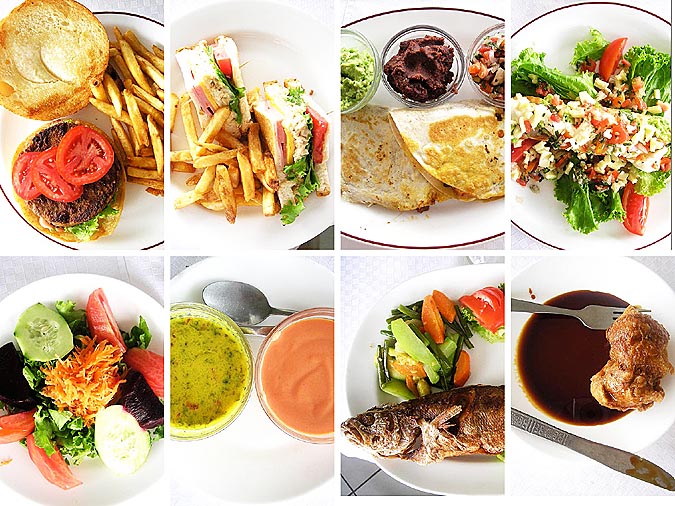AOL Travel reported on how those airplane flights that still serve food actually go about preparing the food (especially after the lousy inspection reviews compiled by USA Today).
.jpg) AOL decided to track a single airline meal, from the time it is planned and placed on an airline’s menu to the moment it arrives at the passenger’s seat.
AOL decided to track a single airline meal, from the time it is planned and placed on an airline’s menu to the moment it arrives at the passenger’s seat.
Or, given the bad press for Gate Gourmet and their bad food safety inspections, the story was a standard PR placement. But some elements of interest:
6 p.m. The passenger confirms her seat assignment – 31A – for tomorrow’s flight from Chicago to London. She doesn’t know it, but her meal choice is getting ready for takeoff, too.
She’s going to select grilled chicken breast with orange sesame ginger sauce, served with jasmine white rice and a side of broccoli and carrots. It’s taken a year of development for this dish to make it to the United menu, with three teams of 35 people considering menu items, procuring ingredients, testing and tasting food, and monitoring the quality of the product to the passenger.
Dishes for United’s Flight 958, which departs in 18 hours, are getting washed at Gate Gourmet catering, right on O’Hare property. In a green effort to conserve resources and reduce waste, United doesn’t have a lot of disposable products, according to Stuart Benzal, United’s managing director of onboard global product. Instead, bowls, plates, cups and other utensils are hauled off the aircraft after each flight and sent to one of the 52 kitchens that United uses around the world.
Most kitchens operate 24 hours. "After 10 at night, it goes into equipment processing (mode)" says Benzal, which means cleaning hundreds of plates, bowls, cups, saucers, trays and utensils for the next day.
2 a.m. Alison Hough, director of product planning, planned and ordered chicken for this meal months ago. She knows, based on customer preferences and numbers, how many chickens to order and send to the caterers. Her team ensures that there is fresh, quality product for all the major components of the meal, while smaller detail items like seasonings are covered by the catering kitchen.
 5:30 a.m. Chef Danielle Nahal and her team of eight to 12 cooks and food handlers, arrive at Gate Gourmet to begin the day’s preparations. The kitchen will be making lots of meals today for flights to London, Asia, Amsterdam and Paris, so the prep work covers 250-300 servings of each entrée. Though the kitchen is very large, it is also very busy and crowded. Nearly 300 people work on a shift, and the kitchen runs 24 hours a day, seven days a week.
5:30 a.m. Chef Danielle Nahal and her team of eight to 12 cooks and food handlers, arrive at Gate Gourmet to begin the day’s preparations. The kitchen will be making lots of meals today for flights to London, Asia, Amsterdam and Paris, so the prep work covers 250-300 servings of each entrée. Though the kitchen is very large, it is also very busy and crowded. Nearly 300 people work on a shift, and the kitchen runs 24 hours a day, seven days a week.
It’s very cold in the kitchens to ensure food safety and food integrity. "You can’t just walk into a kitchen," Benzal says. "You fill out a health form, go to a wash station and wash your hands, use disinfectant, wear a lab coat; your hair and head are covered. There’s even a face mask," he says. "You look more like a surgeon than someone preparing to chop salads." This chilled environment is maintained throughout the production.
6.00 a.m. Twelve hours before flight time, United delivers the final counts and order for meals, including the chicken with orange sesame glaze. Gate Gourmet accepts the order and begins processing to the count specifications. "We’re producing in very large batches," says Chef Nahal. "Sauces are made by the gallon. Vegetables are done by the pound – about 500 pounds [for one day’s meal preparation]."
Executive Chef Gerry Gulli started testing the flavors and sauces for his mandarin chicken nearly a year ago. Since United likes to change out the menus every three months, and needs to have at least two economy meal choices per flight, Chef Gulli is a busy guy. The chefs must also adjust recipes for the diminished taste buds people experience while in flight. "We compensate for that with cooking techniques, using bold flavors and marinades," says Chef Nahal.
9:00 a.m. The grilled chicken breast with orange sesame ginger glaze is being prepared according to recipe instructions. Color photos guide the preparers, so they know exactly how the plate should appear before it arrives at seat 31A.
11.00 a.m. The plated meal for the passenger in 31A, along with nearly 250 other entrées, gets loaded onto trays. Trays are inserted into trolleys, where they sit in a blast chiller until called for delivery to the aircraft.
2:30 p.m. The truck for Flight 958 delivers the meals for the flight, including the chicken with orange sesame glaze destined for seat 31A today. Each high-loader truck takes a trolley of trays, and the driver puts them onto the .jpg) aircraft. The meals fit into a refrigerated compartment. It will take the driver about 30 minutes to get to the aircraft, then another 45 minutes to an hour to load the meals onto the plane.
aircraft. The meals fit into a refrigerated compartment. It will take the driver about 30 minutes to get to the aircraft, then another 45 minutes to an hour to load the meals onto the plane.
6:00 p.m. Flight 958 takes off, bound for London. Flight attendants take economy class meal orders from the three selections: mandarin chicken, a pasta dish, and a beef meal. The passenger in seat 31A chooses the chicken with orange sesame sauce.
7:00 p.m. Flight attendants are busy heating the fully cooked but cold meals in a convection oven. The convection oven circulates the hot air and ensures meals are heated evenly and at the same temperature. It takes about 20 minutes to bring them to dining temperature, and then they are loaded onto carts to head down the aisle.
8:00 p.m. The orange chicken with sesame ginger glaze arrives at seat 31A, hot, colorful, and prepared to Chef Gulli’s specifications.
 sure this does not happen again."
sure this does not happen again.".jpg) characterizations. These changes were often the result of efforts to revive interest in a show whose audience had begun to decline, usually through the employment of different actors, writers or producers.
characterizations. These changes were often the result of efforts to revive interest in a show whose audience had begun to decline, usually through the employment of different actors, writers or producers.
.jpg) AOL decided to track a single airline meal,
AOL decided to track a single airline meal, 5:30 a.m. Chef Danielle Nahal and her team of eight to 12 cooks and food handlers, arrive at Gate Gourmet to begin the day’s preparations. The kitchen will be making lots of meals today for flights to London, Asia, Amsterdam and Paris, so the prep work covers 250-300 servings of each entrée. Though the kitchen is very large, it is also very busy and crowded. Nearly 300 people work on a shift, and the kitchen runs 24 hours a day, seven days a week.
5:30 a.m. Chef Danielle Nahal and her team of eight to 12 cooks and food handlers, arrive at Gate Gourmet to begin the day’s preparations. The kitchen will be making lots of meals today for flights to London, Asia, Amsterdam and Paris, so the prep work covers 250-300 servings of each entrée. Though the kitchen is very large, it is also very busy and crowded. Nearly 300 people work on a shift, and the kitchen runs 24 hours a day, seven days a week..jpg) aircraft. The meals fit into a refrigerated compartment. It will take the driver about 30 minutes to get to the aircraft, then another 45 minutes to an hour to load the meals onto the plane.
aircraft. The meals fit into a refrigerated compartment. It will take the driver about 30 minutes to get to the aircraft, then another 45 minutes to an hour to load the meals onto the plane. nearly double during the next several decades, for the future world population.
nearly double during the next several decades, for the future world population..jpg) The Dallas Morning News reports this morning
The Dallas Morning News reports this morning are 29 laboratory-confirmed cases including seven hospitalizations associated with this outbreak.
are 29 laboratory-confirmed cases including seven hospitalizations associated with this outbreak.  food-wise.
food-wise. Yesterday was Amy’s birthday, so it was champagne and Smurf-inspired colored cupcakes.
Yesterday was Amy’s birthday, so it was champagne and Smurf-inspired colored cupcakes. Eriksen et al. write in Eurosurveillance today
Eriksen et al. write in Eurosurveillance today incident. Temperature control of foods during preparation, cooling, transportation and reheating was poor. Furthermore, the vans used for food transport had no refrigeration and these events took place in July. The evidence of insufficient hygiene, cooling and reheating at the catering company during transport and at both venues (according to environmental health department inspections) are in keeping with a toxin-related gastroenteritis outbreak, including C. perfringens.
incident. Temperature control of foods during preparation, cooling, transportation and reheating was poor. Furthermore, the vans used for food transport had no refrigeration and these events took place in July. The evidence of insufficient hygiene, cooling and reheating at the catering company during transport and at both venues (according to environmental health department inspections) are in keeping with a toxin-related gastroenteritis outbreak, including C. perfringens. “hawking.” That’s the legal term.
“hawking.” That’s the legal term. Owen Wilson character hits bottom and starts crashing funerals to hit on women in emotional distress, or something like that.
Owen Wilson character hits bottom and starts crashing funerals to hit on women in emotional distress, or something like that.